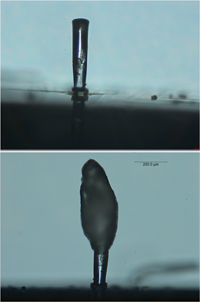Friday, March 27th, 2009
Materials research and engineering continues to increase in structural complexity. Starting from the periodic table of the elements and molecular engineering, over a century of research has explored most obvious phenomena of bulk and thin-film materials. What, then, is left to explore? The vast complexity of natural micro- and nano-scale structures that are indirectly templated by DNA in living organisms. From gecko toes to lotus leafs, bio-inspired researchers have found that studying what nature has evolved points the way to fabricating new functional materials. Georgia Tech researchers used DARPA money to copy and improve on the flow-sensing hairs of the blind cave fish, and talked about it at the American Physical Society meeting on March 20.

Synthetic hair sensor before and after coating with a hydrogel material (source: Georgia Tech researcher Michael McConney)
The blind fish have evolved sparse body hairs that are highly sensitive to the movement of water. “The fish can detect flow slower than 100 micrometers per second, but our system demonstrated flow detection of several micrometers per second,” said Vladimir Tsukruk, a professor in the Georgia Tech School of Materials Science and Engineering who led the work. The researchers knew that the fishy hairs were sensitive, so measuring the hairs with optical and confocal fluorescence microscopy allowed them to set initial size, aspect-ratio, and surface complexity parameters for experiment. The synthetic hairs are formed from a core of standard SU8 photo-epoxy used in MEMS and packaging fabs, then coated with a “cupula” of a UV-cross-linked hydrogel (see figure).
“These hair cells are like well-engineered mechanical sensors, similar to those that we use for balance and hearing in the human ear, where the deflection of the jelly-encapsulated hair cell measures important flow information,” said Vladimir Tsukruk, a professor in the Georgia Tech School of Materials Science and Engineering. “The hairs are better than active sonar, which requires a lot of space, sends out strong acoustic signals that can have a detrimental effect on the environment, and is inappropriate for stealth applications.” If this can be scaled up to Navy specs, then the sensitive ears of whales and dolphins could be saved from active sonar.
To date, the researchers have fabricated an array of eight microsensors and shown that the array is able to detect an oscillating object underwater. They are currently looking for industrial partners to efficiently scale-up the research by fabricating arrays of thousands of these sensors and testing them in real marine environments. The synthetic hairs are in the 0.5-0.8 mm tall range, so many different fab technologies already developed for IC/MEMS packaging using SU-8 could potentially be used. More on synthetic blind fish hairs in a future BetaSights Newsletter. –E.K.
